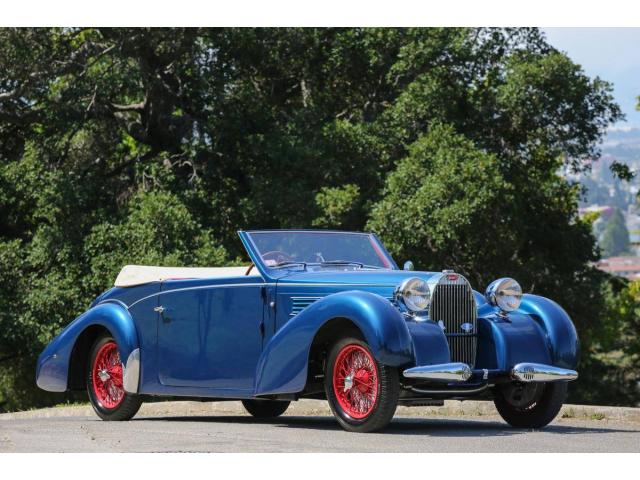1939 Bugatti Type 57 Stelvio Carrosserie Gangloff
- Brand: Bugatti
1939 Bugatti Type 57 Stelvio Coachwork by Carrosserie Gangloff
Many manufacturers during this time produced multi-purpose vehicles that could be driven to a race track, raced, and then driven home. The Bugatti Type 57, however, was solely a road-going vehicle and is considered the most celebrated of all non-racing Bugattis. Even though the Type 57 was strictly a road-going vehicle, a racing version was created for the 1937 24-Hours of Le Mans race. This vehicle, based on the Type 57S chassis and named the 57G, won the race. A supercharged version was created for the 1939 Le Mans race and also was victorious. This is the legacy of the Bugatti heritage and the quality and innovative designs that were truly masterpieces in all respects.
In 1934, the Type 57C entered the scene, a project headed by Jean Bugatti, the son of Ettore Bugatti. The vehicle centered around refinement while focusing on the values that had made Bugatti successful.
Three 'factory' bodies were available and consisted of the Ventoux, a two-window and four window version, the Stelvio, and the Atalante. All of the Atalante bodies were produced and all were done in-house. The Atalante was named after peaks in the Alps and is one of the most exclusive bodystyles ever produced by Bugatti.
The Type 57 could also be ordered with Galibier four-door bodies. Ealier versions of the Galibier bodies had suicide-opening front doors with no pillar. Later versions had suicide-opening front doors and rear doors hung in the traditional fashion. The front and rear doors would share a common pillar.
Jean designed an indepenent front suspension to aide in the handling of the vehicle. This was not popular with Ettore Bugatti and had the traditional Bugatti front axle installed.
A 3.3 liter, twin-cam, straight-eight engine was used to power this vehicle. Even with the heavy saloon bodies, the engine could propel the vehicle to a speed of around 95 mph. A Roots-type supercharger was later added and the vehicle was given the designation 57C. The supercharger was quiet and provided between three to four pounds of boost pressure. The addition of the supercharger increased the horsepower rating to 175.
The Type 57S version was a 'sportier' version of the Type 57. The chassis was shorter, with the rear axle running through the frame. A slightly tuned engine with higher compression and a dry sump lubrication helped increase the performance of the car. The front and rear axles received de Ram shock aborbers, replacing the Hartford Friction dampers.
The Type 57SC was a combination of the 57C and 57S. The engine produced between 200 and 220 horsepower.
On August 11, 1939 while testing a Type 57C tank-bodied racer near Molsheim, Jean Bugatti was killed. This was the same day as the start of the 2nd World War, which inevitably meant that the race Jean was preparing the vehicle for would never be run.
Descriptions & pictures by conceptcarz & dyler & hemmings
| Specification | |
| Production Start | 1939 |
| Country of origin | Italy |































